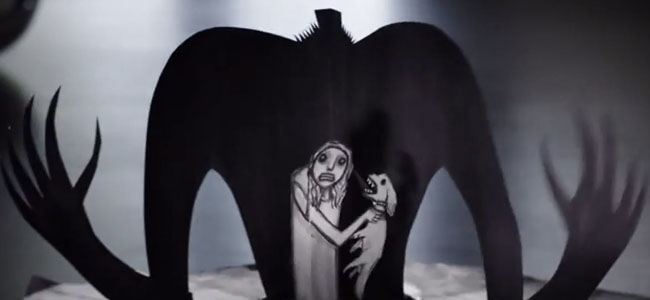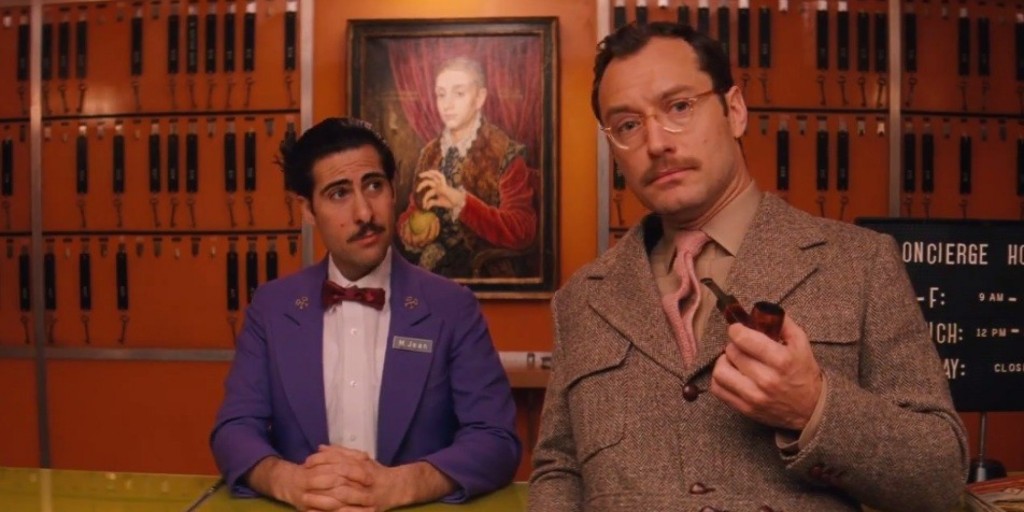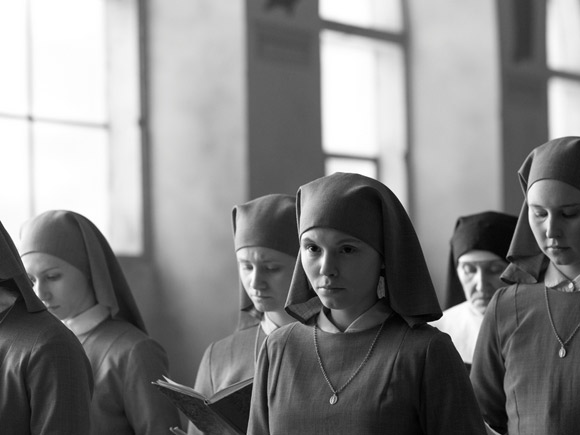By Liam Bouquet
Sadly I have not seen every movie this year, nor have I seen every movie that I personally hoped to see before making this list – “Inherent Vice” and “Goodbye to Language” prominent among them. So if your favorite movie of the year is not included, it could simply mean I never got around to viewing it. Alternatively, it could mean my opinion is simply different than yours. As a third alternative, it could mean I hate you and everything you stand for. Also I am not going to say that this list has eight places — instead of the more orthodox five or ten — because I couldn’t decide which film I wanted to leave out but that is exactly why.
8. ‘The Grand Budapest Hotel’
Wes Anderson and I have a love hate relationship; well, more of a love most of the time but sometimes slightly dislike relationship. Some of his films, I am looking at you “The Life Aquatic”, I was entirely underwhelmed by — feeling they emphasize style over substance. This is not one of those films. “Budapest Hotel” totes Anderson’s penchant for detail and charmingly fantastical set design, but the film is not only stylistically marvelous; it is brimming with heart and wit in its dialogue, story and characters. The human element is here in abundance, and I was hard pressed to find a character in the film that I was ambivalent toward — characters either incurring my admiration or ire in spades. But what pushes the movie from good to outstanding is not Anderson’s charm but the darkness that accentuates the entire piece. The movie is set in a fictional alpine state in Europe that is slowly being overrun by war and a fascist regime. The movie does not just use this setting for some dark comedy and fleeting political statements; for certain there is something deeply distressing about watching a whimsical Anderson mystery while the world around is slowly embroiled in nazi-esque symbolism and gun wielding storm troopers, but the true punch of this tone choice is how you see it contort and destroy a large host of characters who have garnered your love and admiration. The whimsy of the film only serves to make the films darkest moments marvelously poignant. It shows us the inexorable power of the war machine and the beauty that stands so pitifully in its way; in destroying some of the things we grow to love in this movie, Anderson does more than cap off his tale with a maudlin finish. He gives us an object lesson similar to what “The Monuments Men” tried and failed to offer earlier this year. We see the destruction of beauty in the face of man-made machine that is much larger but in no ways greater, and it speaks to the annals of human memory, both contemporary and prehistoric, that have too often been characterized by destruction of life and culture for the endless hunger of despots. The film is a fun ride but it is far from an easy one, and the sharp and often jagged turns left me feeling emotionally whip-lashed by the end; this is not Anderson’s first foray into this territory, but it is one of his best.
7. ‘Two Days, One Night’
A Belgian film about a depressed woman, recently fired after an extended sick leave due to anxiety and depression, tasked with approaching all sixteen of her coworkers and convincing them to give up their bonus in a vote that will assure her job may not seem like most people’s idea of a good time. For the first 15 minutes of the film, I would have enthusiastically agreed. Then the hour and a half film worked some of its enigmatic magic over me with some of my favorite performances — of particular note is Marion Cotillard’s as the leading lady — of the year and a plot that is graspable but rife with ethical nuances. The film very much understands itself, and it is never prone to flashy displays or unearned drama. In the vein of the Italian neorealist movement, the film utilizes mostly unknown actors, basically no soundtrack and extended moments of silence and stilted dialogue between tense characters to make the gritty reality of an unfortunate situation come through the screen unfiltered and immediate. The premise is admittedly monotonous in the beginning minutes — as the main actress must go up to every coworkers door and talk to them one-by-one — but the story takes on a new life once you begin to know and understand the character’s motivations for choices that seem loathsome at first. As said Cotillard’s Sandra is beautifully tragic and understated; it is her particular plight really allows the film to bloom. Quickly the movie takes on its form as a parable of sorts about the tragedies that capitalism proliferates. However the movie never falls to turgid philosophy and empty preaching, instead giving the audience an object and all too familiar lesson to draw their own conclusions with.
6. ‘Birdman’
“Birdman”, at first, appears the type of Oscar bait movie built to dazzle you with neat tricks and fancy camera work — most of the movie plays out uncut — all while being chalk full of cliché and crowded dialogue that attempts to hammer the theme into the viewer’s skull. Not so, Birdman remains lucid and tight throughout its run-time, never feeling too translucent or dissembling in the themes it deals in. It may seem a tad early, in the midst of the superhero craze, to begin deconstructing the actors who portray these box office guzzling champs. But this is Michael Keaton, Batman himself, who dons the ridiculous helm of the Birdman and attempts to drag America’s love of the men and women in tights and/or power armor under the microscope; what a laudable job he does too. The film is not limited in its appeal to the extremely media savvy though, who will certainly get their kicks out of the jargon the films throws around for those considered in the know; instead it offers up not the quintessential washed up actor’s tale but a tale of the existential woe of a man without place, without purpose, and without confidence in an industry that thrives on those attributes. It is a story about meaning in lives that are essentially meaningless. As Emma Stone’s character puts it, Keaton’s Riggan Thomson is a man who is desperately trying to convince himself that he is still important in a world that has forgotten him. This theme is nothing new, but it is delivered with style via a lean but dense script — one that curiously mixes the classic tropes of both the cinematic and theatrical writing style. The movie, with all its pomp and circumstance, distills the worlds of jazz, the theater and New York City itself into a movie rife with electric and addictive energy that characterizes these monolithic cultural icons themselves, but the director also knows when to tell the rest of the movie shut up and just let the characters talk. Also, ever since I saw the movie I can’t help but hear some sweet rhythmic drum hits, straight out of the movie, whenever I do anything appropriately dramatic.
5. ‘Force Majeure’
I will say as little about this one as I can; the key to its plot and its theme is also a fairly substantial moment that deserves to be experienced in its totality with as little prior knowledge as possible. The film follows the hapless ski trip of Tomas and Ebba as the Swedish couple travels to the alps as a family retreat of sorts. Force Majeure translates to an act of God, and it is a legal defense employed to make the conditions of a contract void due to, you guessed it, an act of God. Now, with a name like that, you would expect the film to be as bombastic as your standard Hollywood affair — with a few Swedish peculiarities. The movie, to some degree, wants you to think that; it pulls you in with the tension most horror flicks lack. The machinery groans as it drudges these characters up the mountain; there are haunting and unnerving transitions with controlled alpine explosions set to orchestral pieces exploding with screeching of violins. This is not to say the movie does not fulfill its promise of tension; the tension is just not exactly what I or most viewers would expect, but it is dreadful nonetheless. The movie asks very plainly for the viewer to consider the gender roles played out in the common marriage, the institution of marriage itself and the ever unknowable nature of the people we choose to spend our lives with. Characters are equally pathetic and sympathetic, heroic and fragile throughout the films two hour run-time, and you never are quite certain who or what you want to root for or against. Like most of the films on this list, the film is frightfully realistic in its approach to its drama. Director Ruben Ostlund lingers just long enough on moments of awkwardness and discomfort, showing in his camera work characters inability to process or respond to their situation, to set your teeth to grinding against each other in agony as you wait for the moment to pass. It is an intimate film, almost voyeuristic, but it is well worth the uneasiness.
4. ‘The Babadook’
“The Babadook” will likely be remembered as one of the greatest horror movies of the past few decades — easily entering into the pantheon reserved for the likes of “Let the Right One In”, “The Shining”, “The Silence of the Lambs” and so on. Though the movie, being a relatively traditional horror film, will see little in the way of nominations come award season, this does not detract from the film’s relevancy to cinema. Jennifer Kent, an Australian director, has burst onto the film scene with this perennial flick. Both persistently eerie throughout its run-time and disturbing far beyond the credits, Kent has managed to do what so many other larger budget horror movies have failed to; she has made a good horror movie that is also a good movie. Though the film falls on some tried and true horror movie tropes, it never reduces itself to the jump scares that plague modern horror. The film does not care if you are jumping around in your seat, screeching and screaming, it would much rather leave you wriggling in discomfort, having burrowed under your skin. Contributing to the creepy factor and the film’s overall merits is that every aspect of the film are nearly perfectly executed. Essie Davis, who plays the widowed mother of a troubled child, deserves awards to be chucked at her for her sympathetic and terrifying performance as a woman who slowly falls to insanity — either due to her own psychological turmoil or the machinations of the Babadook. Noah Wiseman, who plays the son, is equally convincing as the both annoying and intrepid troubled child who sees creatures in every corner. In addition, Kent sells her creature and her set, even with the minimal budget, with the unique implementation of stop motion to make the Babadook both temporal and otherworldly at different points and effective lighting that starkly contrast light and dark and plays up the destitution of this ramshackle living quarters. What truly sets the film so far above most of modern horror is not just the raw competency of the script, director, and actors but that the film offers so much more. It is not disturbing because of the creepy crawleys that bump around the film, it is disturbing because it deals in human emotion that illicit sympathy and fear from even those who have never known that type of grief; certainly it may seem like any other monster flick, but it handles themes of loss and mental illness with a skill foreign to most films. So, to cloyingly borrow from the film itself, please let “The Babadook” in.
3 “Listen up Philip”
If you enjoy watching an circus of self-involved assholes parade around the world willingly ignorant or unconcerned of the pain they cause their loved ones, then boy is this the film for you. The antihero is certainly not a concept new to cinema — nor is the charming asshole — but I could not think of a film that is able to pull off this character class with such deftness. It probably isn’t even proper to dub the titular character Philip, portrayed by Jason Schwartman, an antihero, as that would presume he has any heroic qualities to begin with. Philip is self-destructive; he is unwilling to care about the emotions of others unless it suits him, and he is soberly entitled. In the process of the film, he seems to only be capable of making himself and those who are unfortunate enough to step in his path suffer, and the people he purportedly helps — the reader’s of his books — are so far outside of the purview of the film it hardly matters. Yet I loved Philip and his equally noxious mentor Ike Zimmerman, and it wasn’t even their moments of weakness and self-awareness that sold them; more so, it was the bilious and raucously funny comments they would spew at others. They are nihilistic and self-loathing, certainly, but you cannot hate them; it is like watching a lion in the wild. When Philip berates his ex-girlfriend so precisely and leaves her stunned and alone in some depressing diner, there is a languid grace to Philip’s vileness. This is who he is; these qualities are immutable and inalienable from him, so why hate him for it? Philip, rightfully so, is the foundation of this incredible film, and he is the nexus of energy that the film sets itself free in. Even when the film switches perspective to another character, the film is still about Philip. You see, Philip is a fairly unchanging character. Throughout the film he only changes so much as to better follow the path many viewers could predict early on. So, though he is all too quick to monologue on his feelings, it is through characters’ live he deeply impacted, often for the worse, we learn of his deep melancholy that is his torment and his drive to write; Philip, a writer, blossoms through the stories of others fittingly enough. The film speaks with an acerbic and quick wit through most of its run-time, playing out like the modernist books the writers in it probably penned themselves, but though the dialogue is often too snappy and perfectly performed to feel entirely real, the words spoken do; this is a film about more than just the pernicious impact of narcissism but about the depths of love and the loneliness and isolation of those who scorn it, fear it, or seem incapable of feeling it. There is one moment, an extreme closeup of an actress’s face, in which you see the weight of loss take hold in the contortions of her face. This moment speaks well for the movie itself.
2. ‘Under the Skin’
I am not entirely certain that I enjoyed this movie as of yet. For certain, it was an excellent film, but I cannot say that I enjoyed it. In fact, it was a somewhat unpleasant experience. Yes this story of a perplexing alien traveling through Scotland and seducing unexpected men kept me engrossed from start to finish — beginning with a mysterious, almost mechanic, creation or birthing scene for Scarlet Johansson’s alien — and left me deeply disturbed once the credits rolled. So I don’t think I actually enjoyed this movie as much as I experienced it, but not all great art is meant to be enjoyed. I should preface, as I continue, that this strong reaction may simply be unique to me and others will leave the film completely unphased, but there is no denying the film’s dispassionate and alien approach to moments of violence and even horror is at least unsettling. To achieve this end, the film totes an Kubrick-esque tendency toward perfectionism. Every shot, every moment, every look by Johnansson’s character is clearly meticulously gathered as part of a larger tapestry. But this is not to say that the film feels inauthentic, however. For being entirely insane in its premise, the film feels too real in its characters and their reactions to the stimuli the film throws at them. As is common to arthouse films of this sort, that stimuli often does not exist in the world of the real. Though scenes of Johansson wandering around Scotland have a sense of gritty reality to them and all of her conversations with men she picks up or runs into hold that awkward energy of real life introductions, the more surreal scenes certainly seem to have a abstract nature to them. And the film is all the better for that, this approach challenges viewers to come to their own conclusion about Johansson and her goals and struggles, while giving new evidence to either build upon or destroy established theories. Without spoiling anything, all of the film would have likely been impossible without Johansson at the helm. She truly sells the other worldly nature of her character, even in her existential struggles, and it allows the film the unique opportunity to wield the popular conception of Johansson as some starlet vixen as a weapon to deconstruct the entire perception. I have never seen this actress so raw and alive than when she was playing some extraterrestrial man hunter.
1. ‘Ida’
I had heard whisperings of Ida before my friend finally persuaded me to give the film its chance. It sounded, well, unremarkable to me. The film is a sort of austere road trip Polish drama about a novice nun trekking across a small section of Poland with her former Soviet prosecutor aunt to find the remains of her parents — Jews who had perished in the Holocaust. Certainly the film had potential on this premise alone, but I thought back to how over-saturated this era had become in movies, books, TV, and even video games; conclusion, I was not overly excited to see this film. Luckily, I was extraordinarily wrong. When I ended this film, I first noted director Pawel Pawlikowski’s stunning cinematography, which left every moment of the film as beautiful as expertly shot still pictures. I also of course appreciated the first-class acting — of particular note was Agata Trzebuchowska who played the titular character and was not actually an actress but a student — the minimalistic script and practical sets. There was something else though about the film that would not leave me even as I walked away. Certainly it was an extraordinary piece of art that was worthy of reflection, but the film wasn’t just one I reflected on. No, the film endured in my headspace, flitting around the back of my mind even when I had no desire to think on it. Slowly my admiration budded into love, and I, at first, did not entirely know why; it did not seem like the type of film I was wont to truly fall in love with. But, yet, I did fall in love, and in the weeks since my viewing, it has become one of my favorite films of all time. There is both an overt and subtle beauty that permeates the film. It is found as Ida stares upward, her opal-like eyes conveying her confusion and turmoil more than her words could; it is found in the ambient sound of the snow crushing beneath the soles of Ida’s boots as she walks to and from the convent; it is found in how the camera sits upon the actresses as they talk or fight instead of darting back in forth to record each and every reaction down to the size of the pores on their skin; it is found in Ida’s every motion, even though she rarely actually speaks. The characters of this story are alive to me; in my mind, the inhabitants of a 1960s Poland witnessed Ida roam with innate grace from her convent to the alien city. Certainly both her once-communist aunt Wanda and Ida, in their sharp contrast, represent faces of Poland as it recovered from the Holocaust and moved into the drab years of Stalin rule. Yes each speaks volumes on the deeply scarred but enduring cultural identity of the Polish, but they are also creatures of flesh and blood. To take this idea away from would be a nearly impossible task. To me this movie is not a piece of cinema but a miraculously perfect recording of a moment of life.




